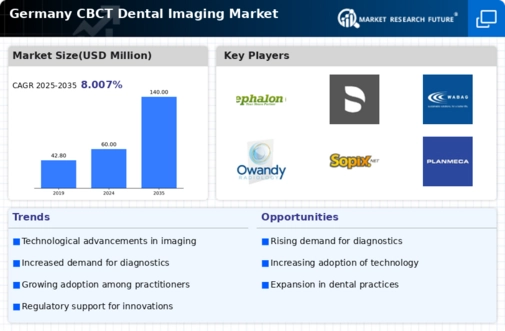Growing Geriatric Population
The demographic shift towards an aging population in Germany significantly impacts the cbct dental-imaging market. As the geriatric population increases, there is a corresponding rise in dental health issues that require advanced imaging for effective diagnosis and treatment. Older adults often face complex dental conditions, necessitating the use of CBCT for accurate assessment. This trend is expected to drive market growth, with projections indicating that the geriatric population will account for over 25% of the total population by 2030. Consequently, dental practices are likely to invest more in CBCT technology to cater to this demographic, thereby enhancing the overall market landscape.
Rising Demand for Diagnostic Accuracy
the cbct dental-imaging market in Germany is experiencing a notable increase in demand for diagnostic accuracy. As dental professionals seek to enhance treatment outcomes, the precision offered by cone beam computed tomography (CBCT) becomes increasingly appealing. This technology allows for detailed 3D imaging, which aids in accurate diagnosis and treatment planning. According to recent data, the market is projected to grow at a CAGR of approximately 8% over the next five years. This growth is driven by the need for improved imaging techniques that can reduce the risk of misdiagnosis and enhance patient satisfaction. As a result, dental practices are investing in advanced imaging technologies, thereby propelling the cbct dental-imaging market forward.
Increased Focus on Preventive Dentistry
The increased focus on preventive dentistry in Germany serves as a significant driver for the cbct dental-imaging market. As dental professionals emphasize early detection and prevention of dental issues, the demand for advanced imaging technologies like CBCT rises. This shift towards preventive care is supported by public health initiatives aimed at improving oral health outcomes. The market is projected to grow as more dental practices adopt CBCT for routine examinations and preventive assessments. With an estimated 30% of dental practices planning to integrate CBCT into their services by 2027, the cbct dental-imaging market is likely to expand, reflecting the changing landscape of dental care.
Integration of CBCT in Dental Education
The integration of cbct dental-imaging technology into dental education programs in Germany is a significant driver for the market. Educational institutions are increasingly incorporating CBCT training into their curricula, ensuring that future dental professionals are well-versed in advanced imaging techniques. This trend not only enhances the skill set of graduates but also promotes the adoption of CBCT technology in clinical practice. As more dental schools emphasize the importance of CBCT, the market is likely to see a surge in demand for these imaging systems. Furthermore, the investment in educational resources and training programs is expected to reach approximately €10 million by 2026, further solidifying the role of education in advancing the cbct dental-imaging market.
Technological Innovations in Imaging Systems
Technological innovations in imaging systems are a crucial driver for the cbct dental-imaging market in Germany. Continuous advancements in software and hardware capabilities enhance the functionality and efficiency of CBCT systems. Features such as improved image resolution, reduced radiation exposure, and faster scanning times are becoming standard in modern CBCT devices. These innovations not only improve diagnostic capabilities but also increase the appeal of CBCT systems among dental practitioners. The market is expected to witness a growth rate of around 7% annually, driven by these technological advancements. As dental practices seek to adopt the latest imaging technologies, the cbct dental-imaging market is poised for substantial growth.





















Leave a Comment